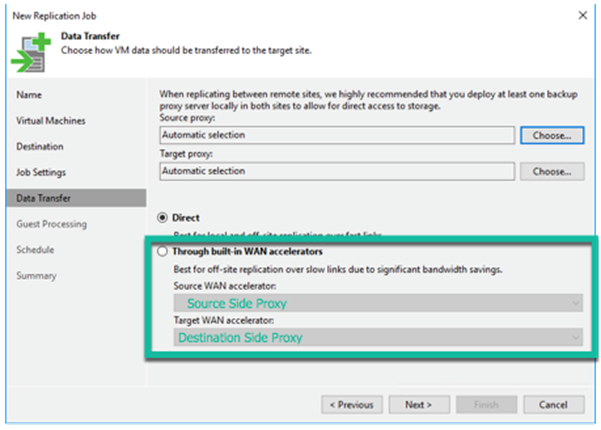Veeam Replication – WAN Accelerator
The Veeam WAN Accelerator is an advanced feature but I decided to give it its own spotlight because how powerful it is.
Licensing wise it requires Enterprise Plus licensing unless you are leveraging cloud connect to a service provider where Enterprise is sufficient.
What is it for? Well it’s for reducing the bandwidth required for transferring either backups or replicas over a WAN.
So, when should it be considered? Let’s start by saying it’s not suitable for every environment. In fact, if your environment has some of the things we are going to talk about later then the WAN Accelerator could actually be a burden.
Do you have a link between 3MB/s and 40MB/s? – This could be the sweet spot and where the WAN Acceleration could work for you and bring you some benefits.
However, although the Veeam WAN Accelerator is included in that Enterprise Plus license you really need to consider that bandwidth availability over the WAN connection. You should see how much it’s going to cost first as with the reduction in bandwidth requirement comes cost on resources to make that happen.
Requirements
If you have determined from the above best practices outlined in the Veeam Best Practices guide here – http://bp.veeam.expert then you will need consider the requirements for your WAN accelerator deployment.
The Veeam WAN accelerator works in pairs which is what we will cover, there is also a solution, many to one.
We will have a WAN Accelerator at the source site, this will require access to the Veeam Management server, at least one source Veeam proxy and the remote site WAN Accelerator.

The target WAN accelerator on the remote site. This one will require access to the same management server, target side Veeam proxy and the source WAN accelerator. It is worth noting here that if you are also using the WAN accelerator for Backup Copy operations the target will also need access to the target repository.
The source Veeam proxy must have access to the Veeam management server, source hosts, source WAN accelerator and backup repository holding replica metadata.
The target Veeam proxy must have access to the Veeam management server, target hosts and target WAN accelerator.
We have also mentioned earlier in the series regarding the replication metadata, this is to be stored within a backup repository on the source site. The closer to the Veeam proxy the better.

Global Cache (6 behaviours of a Global Cache)
- The global cache is a folder on the target WAN accelerator.
- The global cache data is stored in the VeeamWAN folder on the disk with the most amount of space available. (This is default and can be changed)
- The size of the global cache is 100 GB (This is default and can be changed)
- The global cache size is specified per source WAN accelerator.
- The WAN global cache is a “library” that holds data blocks repeatedly going from the source side to the target side.
- The global cache is populated at the first cycle of a remote job.
The Veeam management server is checking the cache every now and again for certain things this is done by monitoring the replicated data and going to the target against the global cache. During this check, it is checking for two different outcomes.
- Any New Data that is required to be sent over the WAN should be added to the cache.
- Any Old Data that is no longer required or is not used as much, this makes room for number 1.
Veeam Backup & Replication will also be checking for consistency against corruption, if blocks are corrupted and found in the cache they will be removed.

There is so much information on the Global Cache this can be found here – https://helpcenter.veeam.com/docs/backup/vsphere/wan_global_cache.html?ver=95
Efficiencies
The whole point to WAN acceleration is to reduce the amount of data going from one site to another or over that WAN.
Deduplication takes place takes place in three areas:
- Virtual Machine Disks – analyse data blocks within the VM disk. If identical blocks are found, duplicates are removed. (step 2 below, Workflow)
- Restore Points – analyse data in the restore point that is about to be replicated against the already replicated restore points. If identical blocks are found, duplicates are removed. (step 5, Workflow)
- Global Cache – analyse data blocks to be sent and compares them with data blocks stored in the global cache. If identical blocks are found, the duplicate on the source is removed. (Step 6, Workflow)
Workflow
Once deployed, head back to your replication job, configure the below setting and determine the Source and Destination WAN Accelerators.

- When this job runs the Source WAN Accelerator will analyse blocks and create a digest that is stored in that VeeamWAN folder.
- Compress Virtual Machine data and copies to target.
- The target WAN accelerator populates the global cache storage with data blocks during the transfer process.
- Each job cycle after will analyse and create new digests.
- Compare the created digests with the digests that have been previously stored on source.
- Analyses restore points that have been previously copied to the target.













Hi! How are you?
Nice work! Tks!
Wan accelerators are used in the failback process?
There is any tweek needed to do this?
Thank you!
BR!
It is not bi directional only source to target due to cache being different on both sides. The failback should only be a small incremental from the changes unless obviously the original source is no longer in place then it could be setup as source target again with WAN acceleration.